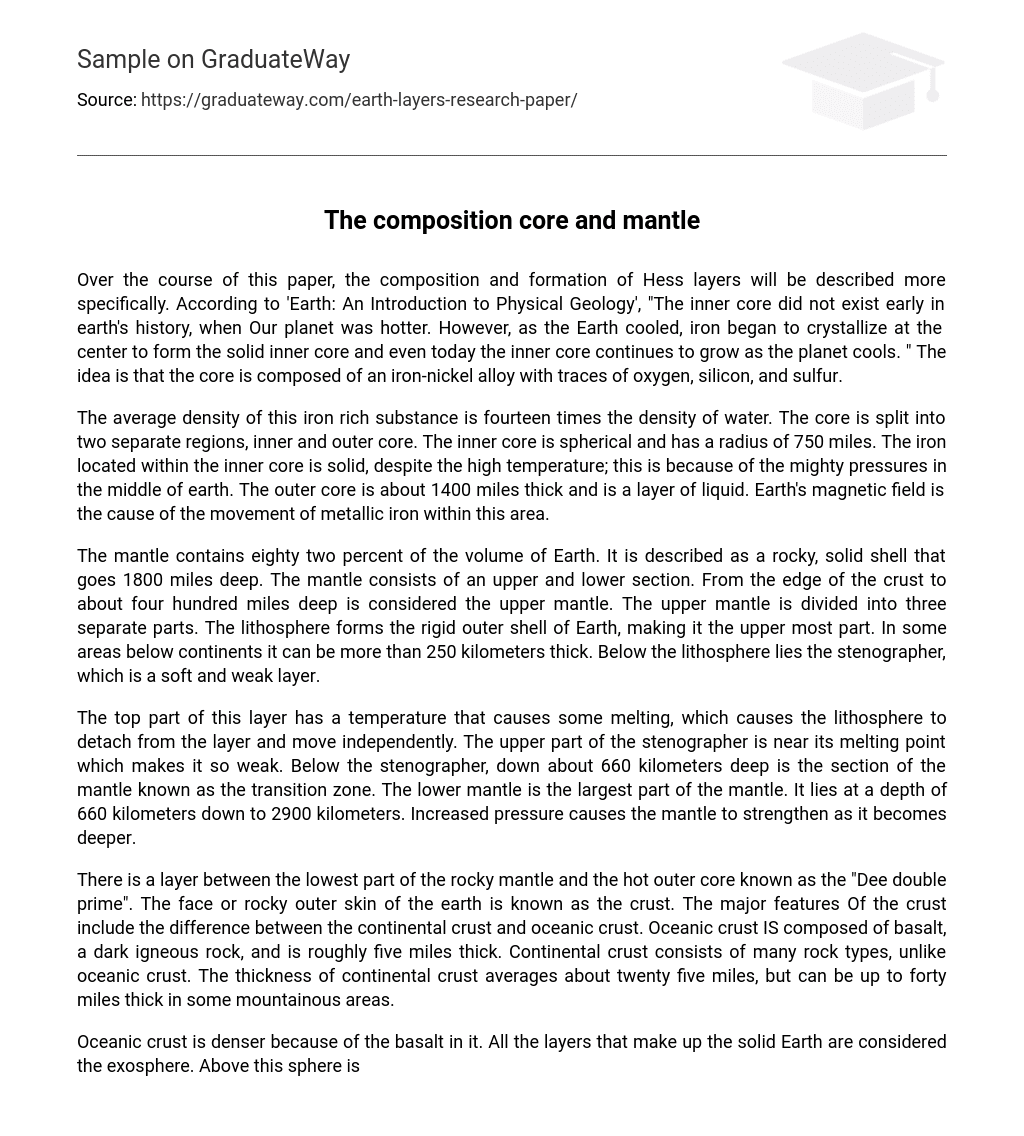Over the course of this paper, the composition and formation of Hess layers will be described more specifically. According to ‘Earth: An Introduction to Physical Geology’, “The inner core did not exist early in earth’s history, when Our planet was hotter. However, as the Earth cooled, iron began to crystallize at the center to form the solid inner core and even today the inner core continues to grow as the planet cools. ” The idea is that the core is composed of an iron-nickel alloy with traces of oxygen, silicon, and sulfur.
The average density of this iron rich substance is fourteen times the density of water. The core is split into two separate regions, inner and outer core. The inner core is spherical and has a radius of 750 miles. The iron located within the inner core is solid, despite the high temperature; this is because of the mighty pressures in the middle of earth. The outer core is about 1400 miles thick and is a layer of liquid. Earth’s magnetic field is the cause of the movement of metallic iron within this area.
The mantle contains eighty two percent of the volume of Earth. It is described as a rocky, solid shell that goes 1800 miles deep. The mantle consists of an upper and lower section. From the edge of the crust to about four hundred miles deep is considered the upper mantle. The upper mantle is divided into three separate parts. The lithosphere forms the rigid outer shell of Earth, making it the upper most part. In some areas below continents it can be more than 250 kilometers thick. Below the lithosphere lies the stenographer, which is a soft and weak layer.
The top part of this layer has a temperature that causes some melting, which causes the lithosphere to detach from the layer and move independently. The upper part of the stenographer is near its melting point which makes it so weak. Below the stenographer, down about 660 kilometers deep is the section of the mantle known as the transition zone. The lower mantle is the largest part of the mantle. It lies at a depth of 660 kilometers down to 2900 kilometers. Increased pressure causes the mantle to strengthen as it becomes deeper.
There is a layer between the lowest part of the rocky mantle and the hot outer core known as the “Dee double prime”. The face or rocky outer skin of the earth is known as the crust. The major features Of the crust include the difference between the continental crust and oceanic crust. Oceanic crust IS composed of basalt, a dark igneous rock, and is roughly five miles thick. Continental crust consists of many rock types, unlike oceanic crust. The thickness of continental crust averages about twenty five miles, but can be up to forty miles thick in some mountainous areas.
Oceanic crust is denser because of the basalt in it. All the layers that make up the solid Earth are considered the exosphere. Above this sphere is called the biosphere. The biosphere includes all forms of life on our planet. The hydrosphere is a mass amount of water that is constantly on the move. From the oceans, it evaporates to the atmosphere, precipitates to the land, and then runs back to the ocean. About seventy percent of the planet’s surface insists of global ocean. The final sphere of Earth is the atmosphere and without it life here would not exist.
The atmosphere is divided into five layers. The troposphere is the layer of the atmosphere closest to Earth. This layer starts at the surface of Earth and extends outward about ten miles. It is in this area that weather occurs. Roughly eighty percent of the atmosphere is located in the troposphere. The stratosphere is the layer above the troposphere. This layer extends thirty miles above the planet’s surface. The temperature of this layer does rise, however it still remains below freezing. The next layer is the mesosphere, and rises about forty to fifty miles above the surface of Earth.
The air is very thin in this layer and can reach temperatures as low as -184 degrees Fahrenheit. This layer is considered the middle atmosphere along with the troposphere. The troposphere extends several hundred miles above the surface. The temperature of this layer can rise up to 2000 degrees Celsius. The troposphere is considered the upper atmosphere. The top of the troposphere is known as the exosphere. The exosphere rises 6200 miles above the Earth. This layer is called the outermost are of Earth’s atmosphere. So how do we know what we know?
Geologists have discovered a lot about the core of our planet by looking at Earth’s magnetic field and measuring seismic waves as they pass through the earth. Changes in these waves are studied, and Geologists are able to draw up conclusions about the Earths density and what it must look like inside. Rocks that originated in the mantle, and were collected at Earth’s surface have provided evidence that supports the composition of our planets interior. Meteorites also provide important clues for the composition of the core and mantle.





